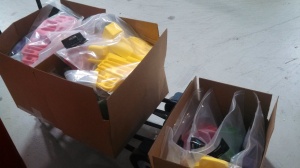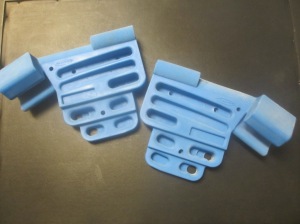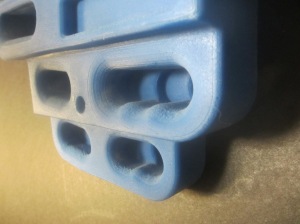The Rock Prodigy Training Center is now available for purchase from Trango’s website! The initial manufacturing run produced a modest number of units, so order right away if you want to be the first climber on your block to have one.
This ground-breaking hangboard was designed by me, with help from my brother Mike and Lamont Smith. In my humble opinion, this is the best hangboard on the market, and is a big leap forward in hangboard design. This board will help beginners unlock the amazing power of hangboard training, by eliminating the top barriers to hangboarding and starting them on the fast-track to finger strength. In my experience, these barriers are pain and risk of injury. This board is exceedingly comfortable, and was built with ergonomics in mind first and foremost.
The most obvious innovation in ergonomics and injury prevention is the two-piece design. I really don’t understand why nobody has created a two-piece board already (though production cost may be one reason). Two independent pieces are absolutely fundamental and essential to safe hangboarding. First, they allow each climber to adjust the hold-spacing to their own shoulder-width, so Jane doesn’t have to do an Iron Cross on Bruce’s board, and Bruno doesn’t have to press his elbows to his ears to use Julie’s board. Second, they allow the two halves to be rotated independently, so the holds on the board can be properly aligned with the climber’s fingers, accounting for variations in finger lengths, and eliminating unsafe strain on the climber’s wrist. Also, nearly every one piece board has a bunch of holds in the center that are useless (for two-arm hangs). This board eliminates that wasted plastic and distributes it where it can be used safely.
All the holds on the board have large-radius, skin-friendly lips to maximize comfort. The board has three textures (completely smooth, medium texture, and rough texture) to give a secure feel on positive surfaces without wrecking your skin. The board includes multiple size options (usually three sizes or more) for all of the most important grip positions, ensuring that climbers of all abilities will find Goldilocks Holds-those that are just right for maximizing your finger strength. Furthermore, the size options provide a built-in ladder of progression that will make the RPTC a valuable training investment for years to come.
While I’m certain the above features will help beginners break into hangboarding, this board was wihtout-a-doubt designed with hardcore training fiends in mind. I’ve been hangboarding seriously for nearly twelve years. By that I mean, three or more seasons per year, with 8-12, 90-minute hangboard sessions per season. That’s literally 100’s of hours spent hanging from all manner of hangboards. Mike has another 15 years of his own experience that went into this design. We wanted to develop a board that would help extremely experienced hangboarders push to the next level, by minimizing all the little annoyances that inhibit your hangboard training sessions (like skin irritation, joint pain, features that encourage cheating, unrealistic shapes and impractical hold sizes). Even if you aren’t a hangboard connoisseur, you will benefit from the thought and attention to detail that went into the design, and you won’t outgrow this board once you become fanatical about training.
Finally, I was determined to develop a practical yet functional means of progressing to smaller grips, without the need to constantly buy more and more hangboards as the climber improves. Often once your hangboard does its job – making you stronger – there is nowhere to go except to a new, expensive hangboard. I’ve gone through five different hangboards over the years, not counting a hodge-podge collection of bolt-on holds I’ve used to supplement my insufficient hangboards. No more! This vicious circle had to stop. The Variable Depth Edge Rails on this board provide an almost limitless ladder of progressively shallower edges to train from. These features, along with the “Position Index Bumps”, allow tremendous variation in hold size without taking up too much space on the board (or resulting in a fragile design). Each climber will be able to find a spot on the Edge Rail that is perfect for their finger size and ability, and then as their fingers strengthen, they can incrementally progress to smaller holds by shifting their hands outward, using the Position Index Bumps as a reference point for repeatable training.

Variable Depth Edge Rails, and Position Index Bumps provide incrementally progression in a practical, compact design. (right half shown)

Slide your hand outward, using the Position Index Bump as a reference point, to incrementally increase difficulty. (Left half shown)
For moving pictures that further describe the features of the RPTC, please check out the “Using the Rock Prodigy Training Center Video” below.



Hey Mark – Awesome video.
It brings up a good point for me, how often do would you advocate doing assisted hangs by using smaller holds rather than doing maximum added weight from a slightly larger hold? It has always been an area of confusion for me because I know that a key concept of training for climbing is specificity, and when climbing outside we’re usually going to be falling because a hold is too small or thin. So training smaller edges would seem like the logical direction to go for specificity, but when I read from people online like Eva Lopez, it seems that the research done shows that more strength gains were seen from a protocol suggesting maximum added weight before doing minimum edge depth.
Just curious to hear more about your perspective on the matter as you have tons of experience…
Thanks!
Joel
LikeLike
Joel,
If you haven’t already, please check out this post, which should answer your question. The bottom line is, we should train on holds that most closely represent the holds we plan to perform on (in terms of size and shape). For most climbers in the US, that will mean small holds, perhaps with weight removed (from body weight).
That said, at a certain point the holds you use may become so small that they are impractical to replicate in training (I’ve been in that situation for a while). If I were to train on truly representative holds, my skin would get completely shredded each workout. So instead, I use holds that are slightly larger, and smoother, so I can complete my workouts without detroying my skin. Holds have to get pretty small before that is a significant problem (less than 1 pad), so for most climbers, using holds that replicate their goal routes is still advisable.
Mark
LikeLike
Just ordered the board! Now when can I buy the book?
LikeLike
Unfortunately it will be another few months before the book is out. Once the book goes to the printer, it will take about 3 months to get printed and delivered to retail outlets. It hasn’t gone to the printer yet, so expect it some time in the new year.
Mark
LikeLike